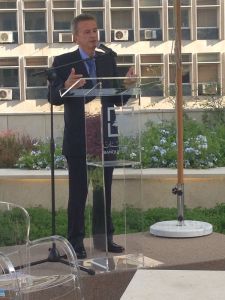Nearly 90% of the Lebanese population resides in cities across the country, with 0.8 square meter per person of green spaces available. The world health organization, however, recommends a minimum of 9 square meter of green space per person, and it is acknowledged that a city at an ideal standard would have between 10 – 15m² of green space per person. Green spaces have positive effect on people; they provide a great way to escape the stresses of day-to-day life, constitute a buffer to the surrounding noises and pollution, and increase value of real estate in surrounding areas
Since we must strive to increase the areas of green space in Beirut and other cities in Lebanon, green roofs provide a supporting action that can be taken to beautify our city in places where green parks can no longer be constructed.
By definition, a green roof is a roof space covered by vegetation that enhances both aesthetics and energy performance of the building, hence increasing the share of green spaces. In addition, green roofs are considered as insulating components reducing energy consumption by 10% due to their layers (soil, plants and water). They absorb the heat and hence reduce the need for conditioning in the space right beneath it, and to lower floors albeit to a lowered extent. On the environmental aspect, green roofs help reduce CO2 emissions through the lowering of conditioning demand.
An 834 square meter Green Roof at the Central bank main branch in Hamra was completed as a joint collaboration between the UNDP – CEDRO project and Banque Du Liban (BDL). This project is one of the first of its kind in Lebanon and the region, and serves as a model project that will, hopefully, be adopted by the public and private sectors, and encouraged.
The pilot green roof initiative was funded by both BDL and UNDP. The UNDP contribution is funded by the Government of Spain through the Lebanon Recovery Fund that supports the CEDRO project. The roof was designed by a local company supported by international experts. It has a growing media consistent of: peat, sand, gravel, old rubber tires, rockwool, perlite or vermiculite and monitored by sensors connected to a control room, measuring water and nutrients level. While phase 1 features a horizontal cover with native species showcasing patterns in their different colors, heights and blooming season, phase 2 emphasizes on the verticality of the elements with three European olive trees. The plant selection stressed on different blooming seasons, to guarantee a continuous flourished roof.

